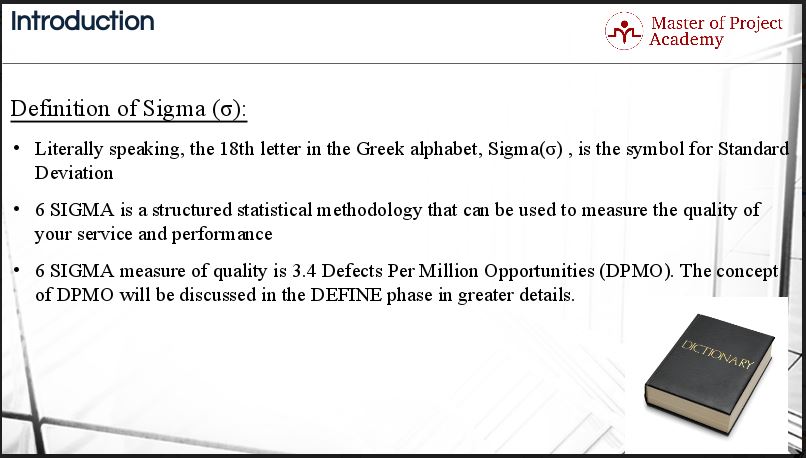As a project manager or manufacturer, you may have come across the term – 6 Sigma. But you may also have asked yourself: what does 6 Sigma mean? Perhaps you have learned a little about it and you’re thinking that maybe 6 Sigma is too difficult for you or that it would not add value to your business. You are wrong! 6 Sigma is based on statistics which can make it look difficult, but if you take a free Six Sigma course you will realize that the Six Sigma Principles are in fact really simple. You will quickly want to enroll into a green belt training to obtain a Six Sigma Green Belt.
Let’s ask a simple question: What is 6 Sigma?
6 Sigma is a rigorous and highly disciplined Business Improvement Process adopted by companies to help focus on developing and delivering near-perfect products and services. Six Sigma Certification helps you to become a Six Sigma practitioner.
Attend our 100% Online & Self-Paced Free Six Sigma Training.
Mikel Harry, President, and CEO of Six Sigma Academy defines 6 Sigma as:
‘A business process that allows companies to drastically improve their bottom line by designing and monitoring everyday business activities in ways that minimize waste and resources while increasing customer satisfaction’
Therefore 6 Sigma is a customer focused business improvement process. The success of any 6 Sigma project is based on team efforts, right from top to bottom. It’s very important that Team Leaders, at all levels, know something about the workings and evolution of teams. This approach to problem-solving is completely data driven and based on statistical tools. That is why it is said to be driven by logical reasoning.
The 6 Sigma Process Steps and Approach
The 6 Sigma process consists of 5 steps which can be abbreviated as DMAIC. It stands for Define, Measure, Analyze, Improve, and Control. It is the foundation of 6 Sigma. The DMAIC process is the classic problem-solving process. DMAIC resolves issues of defects or failures, deviation from a target, excess cost or time. DMAIC addresses improvements in Productivity (How Many), Financial (How Much Money), Quality (How Well) and Time (How Fast) – abbreviated as PFQT.
In 6 Sigma you will often see the equation Y=F(x): This equation represents the mechanism and approach of 6 Sigma. It is the core formula. Typically, “Y” is referred to as the Output, “X” as Input and the process that produces the output is referred to as F. It is read as “Y is the function of single or multiple Xs”. At this stage, please remember that measuring Xs and Ys is not an end in itself. Xs have to be connected or related to Ys.
Take a look at few examples. For instance:
- If “X” is the cycle time, then “Y” might be on-time delivery
- If “X” is the quality of work done, then “Y” might be the level of customer satisfaction.
Check our Six Sigma Training Video
Briefly, 6 Sigma focuses on making the process robust and reducing variability. One of the most important aspects of this problem-solving approach is that: “Applies to any process”. Yes, you’ve got it right. 6 Sigma applies to any process irrespective of the industry, company, and/or domain you are associated with. Although it leans toward production processes, it can also be applied to the transactional process.
Let’s look at a few definitions of 6 Sigma
Sigma
Why is this process called 6 Sigma? The process has five steps, so why not call it Five Steps? That is because the name of this problem-solving process refers to the standard deviation that is allowed in order to achieve 99% accuracy in a process. Literally speaking, the 18th letter of the Greek alphabet, Sigma(σ), is the symbol for Standard Deviation. The Standard Deviation is a measure of how a given set of numbers are spread out. In other words, it is one of the measures of dispersion or you can call it variation. In 6 Sigma, the problem-solving process aims to reduce variation in any given process to 6 standard deviations from the target.

Statistical process control
6 Sigma is a structured methodology to measure the quality of your service and performance. Its methodology is based on established Statistical Process Control (SPC) techniques, data analysis methods and systematic training of all personnel involved in the activity or process targeted by the program.
Defects per million opportunities
The term “Six Sigma” defines an optimum measurement of quality, specifically 3.4 Defects Per Million Opportunities (DPMO). What does the word “Opportunity” mean in this context? Let’s describe it in simple words. An opportunity means the chance to commit an error. Let’s say that you are producing a bottle of water. There are several opportunities for error in producing a bottled water, for example, the cap can be placed incorrectly and the label can be skew. Therefore, for every 500 000 bottles of water produced, there are, to use our example, a million opportunities for defects. We are aiming for only 3.4 defects per million opportunities. Achieving a level of accuracy where only 3.4 defects per million are produced, it signifies that an accuracy of 99.9997% has been achieved. This relates to a DPMO of 3.4 = 99.9997% Accuracy.

There is a lot more to Six Sigma than what is described here. Each of the process steps: Define, Measure, Analyse, Improve, and Control, has specific processes and definitions unique to that step. This is a comprehensive problem-solving approach that starts with understanding the voice of the customer and ends with a controlled process that delivers only the minimum defects per million opportunities. Six Sigma doesn’t stop there. The process that has been improved upon to deliver on the needs of the customer must be constantly monitored to ensure that it stays within the target. That is where the Control stage is of critical importance. It is a live process that must be managed by process owners and process teams. It is important that all team members working on a 6 Sigma buy in to the end goal to ensure their full cooperation.
Review by: Martin Mason



11 thoughts on “What Is 6 Sigma and What Are Its Critical Components?”
Comments are closed.